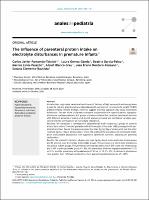| dc.contributor | Vall d'Hebron Barcelona Hospital Campus |
| dc.contributor.author | Parramon Teixido, Carlos javier |
| dc.contributor.author | Gomez Ganda, Laura |
| dc.contributor.author | Garcia Palop, Beatriz Magdalena |
| dc.contributor.author | Lines Palazón, Marcos |
| dc.contributor.author | Blanco Grau, Albert |
| dc.contributor.author | Montoro Ronsano, J. Bruno |
| dc.contributor.author | Clemente Bautista, Susana |
| dc.date.accessioned | 2022-05-02T12:59:42Z |
| dc.date.available | 2022-05-02T12:59:42Z |
| dc.date.issued | 2021-09 |
| dc.identifier.citation | Parramón-Teixidó CJ, Gómez-Ganda L, Garcia-Palop B, Linés-Palazón M, Blanco-Grau A, Montoro-Ronsano JB, et al. The influence of parenteral protein intake on electrolyte disturbances in premature infants. An Pediatría. 2021 Sep;95(3):139–46. |
| dc.identifier.issn | 2341-2879 |
| dc.identifier.uri | https://hdl.handle.net/11351/7443 |
| dc.description | Nounats prematurs; Hipercalcèmia; Hipofosfatèmia |
| dc.language.iso | eng |
| dc.publisher | Elsevier |
| dc.relation.ispartofseries | Anales de Pediatría;95(3) |
| dc.rights | Attribution-NonCommercial-NoDerivatives 4.0 International |
| dc.rights.uri | http://creativecommons.org/licenses/by-nc-nd/4.0/ |
| dc.source | Scientia |
| dc.subject | Nutrició parenteral - Efectes secundaris |
| dc.subject | Infants prematurs |
| dc.subject.mesh | Parenteral Nutrition |
| dc.subject.mesh | /adverse effects |
| dc.subject.mesh | Refeeding Syndrome |
| dc.subject.mesh | Infant, Premature |
| dc.title | The influence of parenteral protein intake on electrolyte disturbances in premature infants |
| dc.title.alternative | Influencia del aporte proteico parenteral en las alteraciones electrolíticas en recién nacidos prematuros |
| dc.type | info:eu-repo/semantics/article |
| dc.identifier.doi | 10.1016/j.anpede.2020.10.001 |
| dc.subject.decs | nutrición parenteral |
| dc.subject.decs | /efectos adversos |
| dc.subject.decs | síndrome de realimentación |
| dc.subject.decs | recién nacido prematuro |
| dc.relation.publishversion | https://doi.org/10.1016/j.anpede.2020.10.001 |
| dc.type.version | info:eu-repo/semantics/publishedVersion |
| dc.audience | Professionals |
| dc.contributor.organismes | Institut Català de la Salut |
| dc.contributor.authoraffiliation | [Parramón-Teixidó CJ, Gómez-Ganda L, Garcia-Palop B, Ronsano JB, Clemente-Bautista S] Servei de Farmàcia, Vall d’Hebron Hospital Universitari, Barcelona, Spain. [Linés-Palazón M] Servei de Neonatologia, Vall d’Hebron Hospital Universitari, Barcelona, Spain. [Blanco-Grau A] Laboratori Clínic, Vall d’Hebron Hospital Universitari, Barcelona, Spain |
| dc.identifier.pmid | 34507648 |
| dc.rights.accessrights | info:eu-repo/semantics/openAccess |

